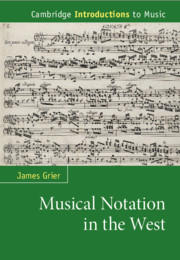Book contents
- Musical Notation in the West
- Musical Notation in the West
- Copyright page
- Dedication
- Contents
- Figures
- Tables
- Musical Examples
- Preface
- Chapter 1 Introduction: Musical Notation as a Symbolic Language
- Chapter 2 Plainsong and the Origins of Musical Notation in the West
- Interlude 1: The Problem with Pitch
- Chapter 3 Polyphony and Rhythmic Notation
- Interlude 2: Rhythm and Metre
- Chapter 4 The Transition to the Modern Era: Instrumental Music and Performing Indications
- Interlude 3: The Score
- Chapter 5 Notational Nuance in the Twentieth Century and the Motives for Notational Innovation
- Coda: The Meaning of Musical Literacy
- Bibliography
- Index
- Cambridge Introductions to Music
Interlude 3: The Score
Published online by Cambridge University Press: 28 January 2021
- Musical Notation in the West
- Musical Notation in the West
- Copyright page
- Dedication
- Contents
- Figures
- Tables
- Musical Examples
- Preface
- Chapter 1 Introduction: Musical Notation as a Symbolic Language
- Chapter 2 Plainsong and the Origins of Musical Notation in the West
- Interlude 1: The Problem with Pitch
- Chapter 3 Polyphony and Rhythmic Notation
- Interlude 2: Rhythm and Metre
- Chapter 4 The Transition to the Modern Era: Instrumental Music and Performing Indications
- Interlude 3: The Score
- Chapter 5 Notational Nuance in the Twentieth Century and the Motives for Notational Innovation
- Coda: The Meaning of Musical Literacy
- Bibliography
- Index
- Cambridge Introductions to Music
Summary
Western art music distinguishes itself from the music of many other cultures by the use of polyphony. The need to show the simultaneous progression of two or more lines of music has generated a number of novel solutions over the millennium or so that Western musicians have practised polyphonic music. Monophony, of course, poses no particular problems of layout. Medieval scribes of monophonic music chose to write the music from left to right, borrowing the conventions from writing text, largely because monophony was texted. They inscribed the music either all the way across the page or in columns, but that choice did not materially affect the presentation of the music or its apprehension in reading or copying. The earliest practical sources for polyphony, the Winchester tropers of the early eleventh century, write the voices separately as monophony, in distinct sections of the book or even in two books.
- Type
- Chapter
- Information
- Musical Notation in the West , pp. 181 - 189Publisher: Cambridge University PressPrint publication year: 2021

